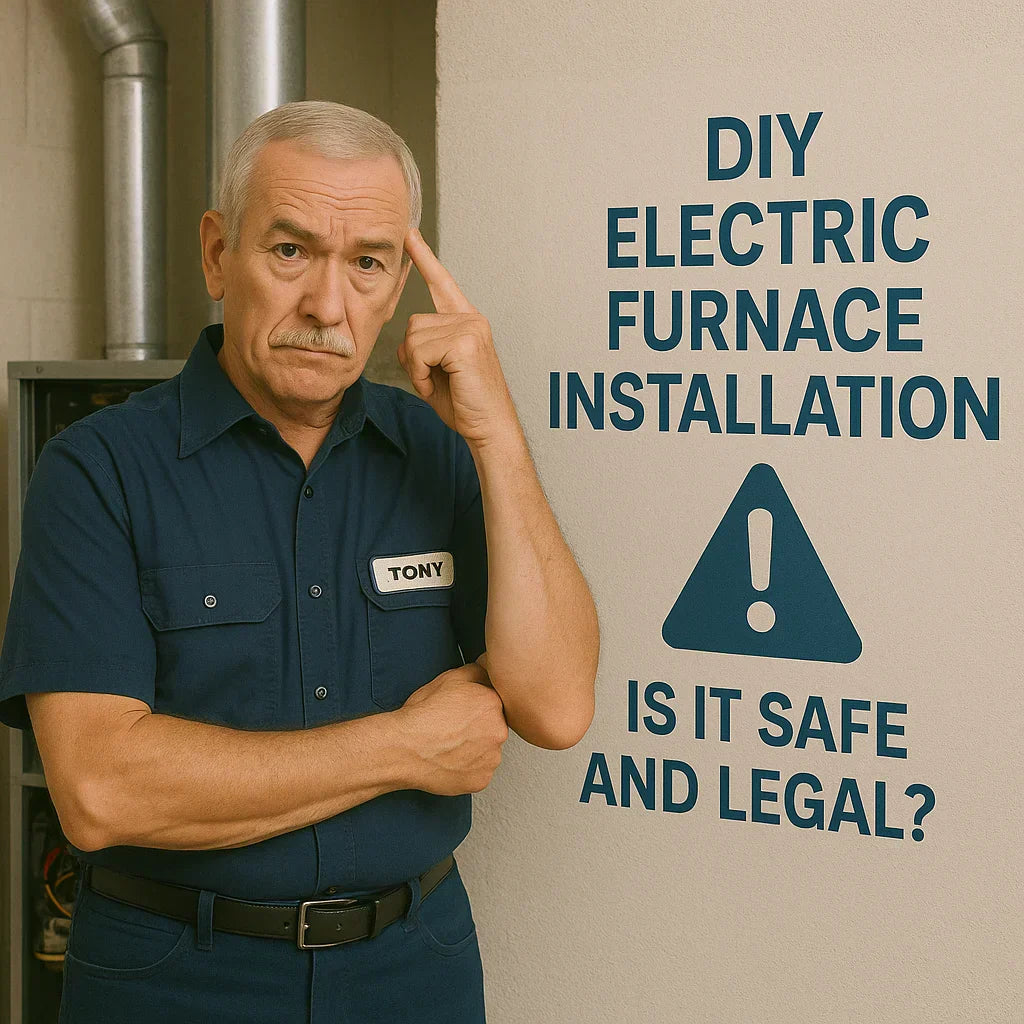🏡 Introduction: The Growing Temptation to DIY
With online tutorials and easily available parts, many homeowners wonder if they can save thousands by installing an electric furnace themselves. After all, electric furnaces have no gas lines or venting to worry about. But is DIY electric furnace installation really safe? Legal? Cost-effective? In this comprehensive guide, Tony Marino breaks down everything you need to know before you even think about taking the DIY route.
🔓 Electric Furnaces: Why They Appear DIY-Friendly
-
Simpler design than gas/oil systems
-
No combustion, flue, or venting
-
No fuel storage tanks
-
Smaller physical footprint
-
Seemingly “plug and play” if existing ductwork is already in place
U.S. Department of Energy - Understanding Electric Furnaces
🏦 But Here’s Where DIY Hits Serious Legal & Safety Roadblocks
-
Electrical Code Compliance:
-
High amperage requires dedicated circuits
-
Wiring must meet National Electrical Code (NEC) standards
-
Panel upgrades often required
-
-
Permit Requirements:
-
Most jurisdictions require HVAC and electrical permits for furnace installs
-
Inspections are mandatory for insurance and resale
-
-
Manufacturer Warranty Voidance:
-
Most manufacturers void warranties if not professionally installed by licensed contractors
-
-
Liability & Insurance Risks:
-
Improper DIY work can lead to denied insurance claims after electrical fires or injury
-
NFPA - National Electrical Code Overview
🌬️ The Electrical Challenge: High Voltage Dangers
| Furnace Size | Voltage | Amperage Requirement | Circuit Size |
|---|---|---|---|
| 10 kW | 240V | ~42 amps | 50 amp breaker |
| 15 kW | 240V | ~63 amps | 70 amp breaker |
| 20 kW | 240V | ~84 amps | 90-100 amp breaker |
-
Mistakes in wiring can cause severe electrocution hazards
-
Improper wire sizing leads to overheating and fire
-
Improper grounding or neutral connections risk arcing faults
The Spruce - Electrical Panel Safety
🔧 What DIYers Can (Sometimes) Legally Do Themselves
-
Replace existing thermostats
-
Swap air filters
-
Clean and inspect ductwork
-
Minor repairs to registers or grilles
-
Visual inspections of insulation and air leakage
Not Legal in Most States Without Permits:
-
Connecting high-voltage wiring
-
Installing new breakers or subpanels
-
Installing the furnace unit itself
-
Making changes to duct design or load calculations
🏛️ Permit and Inspection Requirements: State-by-State Overview
-
California: Requires licensed C-20 HVAC contractor for furnace installation
-
Texas: Permits required for HVAC and electrical modifications
-
Florida: Requires licensed mechanical contractor; strict electrical rules
-
New York: Local municipalities regulate permitting; almost all require licensed trades
-
Oregon/Washington: Allows limited homeowner electrical permits with competency exams
DSIRE - State Energy & Installation Codes Database
🤝 Insurance Companies Weigh In: The Ultimate Risk
-
Most homeowner insurance policies require all HVAC work to be permitted and inspected.
-
Claims related to unpermitted DIY work may be fully denied after fire or injury.
-
In severe cases, policies can be canceled retroactively if unlicensed work is discovered.
Insurance Information Institute - Home Insurance HVAC Coverage
📈 How Much DIY Actually Saves vs. What You Risk Losing
| Task | Professional Cost | DIY Potential Savings |
| Furnace equipment | $3,000 | $0 (same cost) |
| Installation labor | $1,500 | $1,500 |
| Electrical panel upgrade | $2,000 | $1,500 |
| Permits | $300 | $0 (illegal without permit) |
| Warranty validity | $4,000+ value | $0 (voided) |
-
Short-term savings of $2,000-$3,000
-
Risking $10,000+ in denied insurance claims and long-term problems
👨💻 Are There Legal Workarounds? Partial DIY Options
-
Pre-install prep work:
-
Clean and seal ducts ahead of pro install
-
Clear work area for easier access
-
-
Post-install add-ons:
-
DIY install of smart thermostat after furnace professional install
-
Upgrade air filters or install air purifiers
-
Energy Star - DIY Home Performance Projects
🏦 Why Most Professionals Strongly Advise Against DIY Furnace Installs
-
Electrical licensing protects both homeowners and contractors
-
Manufacturer certification ensures correct startup and commissioning
-
Permits verify correct equipment sizing and load calculations
-
Insurance carriers rely on city inspections to validate safety
NECA - Why Hire a Licensed Electrician
🥇 The Hidden Value of Professional Installation
-
Warranty Protection:
-
Full manufacturer parts & labor coverage
-
-
Safety Verification:
-
Proper grounding, load testing, circuit balancing
-
-
Sizing Accuracy:
-
Professional load calculations ensure correct kW rating
-
-
Ductwork Optimization:
-
Airflow balancing improves comfort and efficiency
-
-
Code Compliance:
-
Eliminates future permit issues when selling home
-
🤓 Tony Marino’s Candid Advice to Homeowners
-
"The labor savings aren’t worth the long-term headaches."
-
"You’re dealing with high-voltage electricity—mistakes can be fatal."
-
"Paying for professional install protects your home’s resale value."
-
"Even minor code violations can void your insurance."
-
"Stick to DIY where it’s safe—duct sealing, filters, and thermostat upgrades."
📍 Get Licensed Installation Support from The Furnace Outlet
The Furnace Outlet offers certified installation services across the country, ensuring your new electric furnace is installed safely, legally, and backed by full warranties. Visit The Furnace Outlet Electric Furnaces Collection to schedule your professional installation consultation.
In the next topic we will read about: Top Electric Furnace Brands for 2025: Tony Marino's Expert Picks







